Ads by TS (Virus Removal Guide) - Free Instructions
TS ads Removal Guide
What is Ads by TS?
Ads by TS – adware which approaches while using the original Google search engine
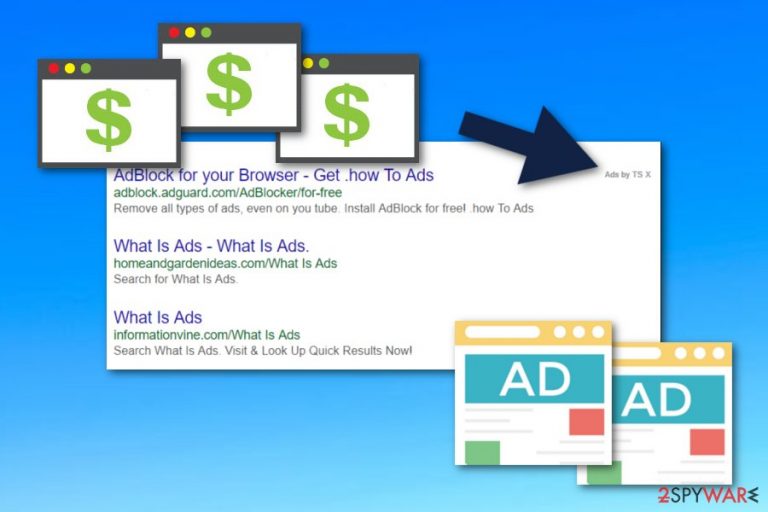
Ads by TS is an adware application[1] which usually appears for users who use the Google search engine. Some users have complained about this potentially unwanted program in the Malwarebytes forum.[2] They have claimed that when performing a search request via Google, rogue notifications appear with the name “Ads by TS” and it happens to various web browsers, including Google Chrome, Mozilla Firefox, Internet Explorer, Microsoft Edge, and Safari. Moreover, it is known that when scanning the computer with the Farbar scan software, it detects adware-related files such as FIRST.txt and Addition.txt. Nevertheless, this type of program can show up on both Windows and Mac operating systems.
| Name | Ads by TS |
|---|---|
| Type | Adware |
| Sub-type | PUP |
| OS infected | Windows and Mac OS X |
| Infected browsers | Chrome, Firefox, Explorer, Edge, etc. |
| Related files | FIRST.txt, Addition.txt |
| Spreading | Bundled programs, infected Internet pages |
| Detect it | FortectIntego is a tool created for PUP detection purposes |
Once infected with Ads by TS, users might start experiencing suspicious browser changes such as:
- injection of adware-related browser plug-ins;
- modification of the homepage;
- the new tab URL bar changes.
After these modifications, you are very likely to experience annoying advertising posts. Once Ads by TS virus starts bombarding your computer with pop-up notifications, they might come with names such as “Ads by TS”, “Powered by TS”, “Brought to you by TS”, “Ads Powered by TS”, and “RocketTab powered by TS”.
Developers gain income from Ads by TS by promoting the cost-per-click marketing technique.[3] However, this is not the only thing which brings the creators benefit. Adware programs also are created to gather non-personal data such as browsing-related information. All relevant details are shared with third-parties and also result in receiving more income.
Additionally, this adware program can promote various uncertain products and push notifications which seek to convince users to purchase specific software or services which end up being totally useless. However, the most important reason to remove Ads by TS virus is the redirecting activity which might take you to malware-laden pages.
Avoid the risk of getting infected with dangerous cyber threats such as ransomware or trojans. For Ads by TS removal, you can use reliable computer software or complete the process on your own. If you are looking forward to detecting all content with anti-malware, we can suggest you FortectIntego. For manual guide, check below the article.
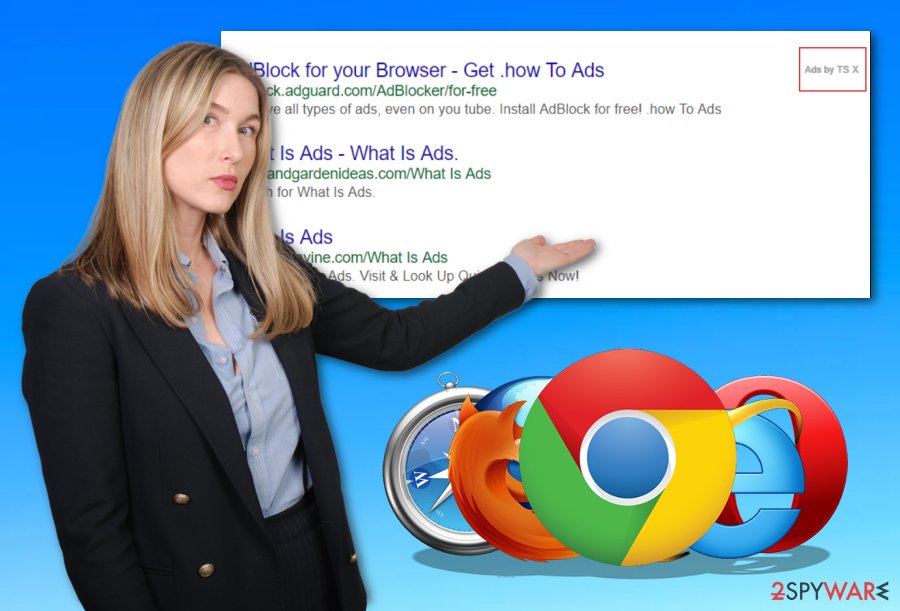
Distribution techniques of adware programs
As we already know, adware-type programs can infiltrate the computer system easily and it does not matter what kind of operating system you are using. Make sure that your Windows or Mac OS is always up-to-date, do not leave any outdated programs on your computer. Additionally, ensure that no suspicious apps appear on the machine.
For the before-mentioned purpose, you need to opt for the Custom or Advanced installation mode. This variant allows you to track and control all incoming downloads. Moreover, make sure that you do not skip any downloading and installing steps. This is necessary if you do not want to let any rogue programs in your computer system.
Additionally, be aware of third-party websites such as peer-to-peer networks. These pages often come improperly disclosed and might also distribute potentially unwanted programs. If you ever encounter a suspicious-looking website, make sure that you close it the same minute and never try returning back.
Ads by TS can be removed without any troubles if done with big care
You can remove Ads by TS successfully on your own if you complete each step as required from the manual step-by-step guide that we have presented below. Here you will need to clean your operating system on your own and refresh web browsers such as Google Chrome, Mozilla Firefox, Internet Explorer, Microsoft Edge, and Safari.
However, according to cybersecurity experts from Virusai.lt,[4] adware elimination, including the Ads by TS removal, is better to perform automatically if you feel that you lack experience as a computer user. Choosing a reputable program increases the chances of eliminating all adware-related components successfully from different locations of the computer.
You may remove virus damage with a help of FortectIntego. SpyHunter 5Combo Cleaner and Malwarebytes are recommended to detect potentially unwanted programs and viruses with all their files and registry entries that are related to them.
Getting rid of TS ads. Follow these steps
Uninstall from Windows
If Ads by TS was installed somehow on your Windows computer, you can get rid of the adware program from your machine by following these instructing steps:
Instructions for Windows 10/8 machines:
- Enter Control Panel into Windows search box and hit Enter or click on the search result.
- Under Programs, select Uninstall a program.
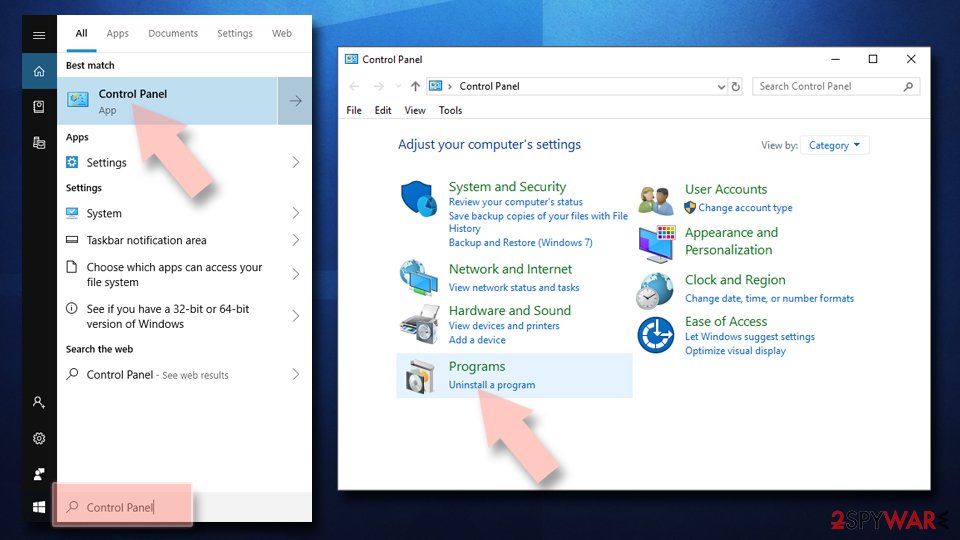
- From the list, find the entry of the suspicious program.
- Right-click on the application and select Uninstall.
- If User Account Control shows up, click Yes.
- Wait till uninstallation process is complete and click OK.
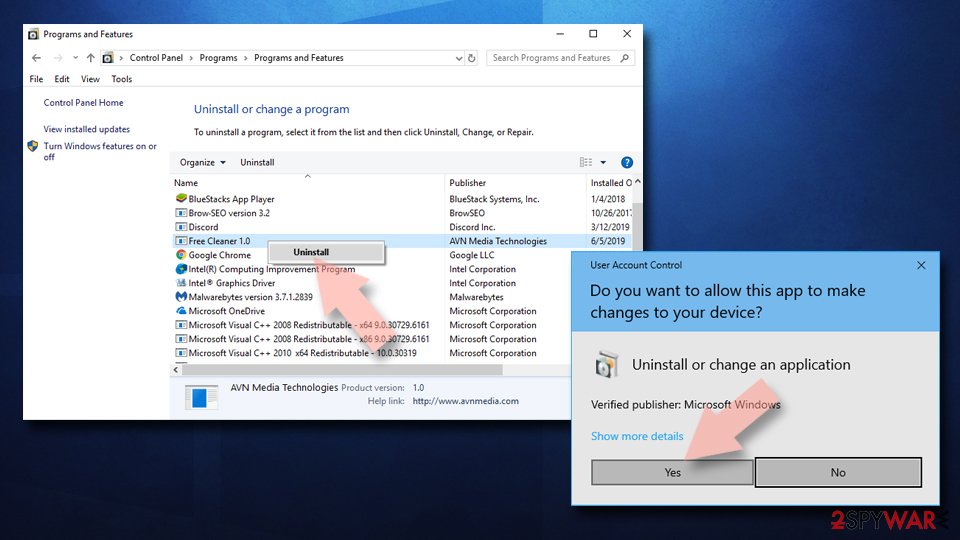
If you are Windows 7/XP user, proceed with the following instructions:
- Click on Windows Start > Control Panel located on the right pane (if you are Windows XP user, click on Add/Remove Programs).
- In Control Panel, select Programs > Uninstall a program.
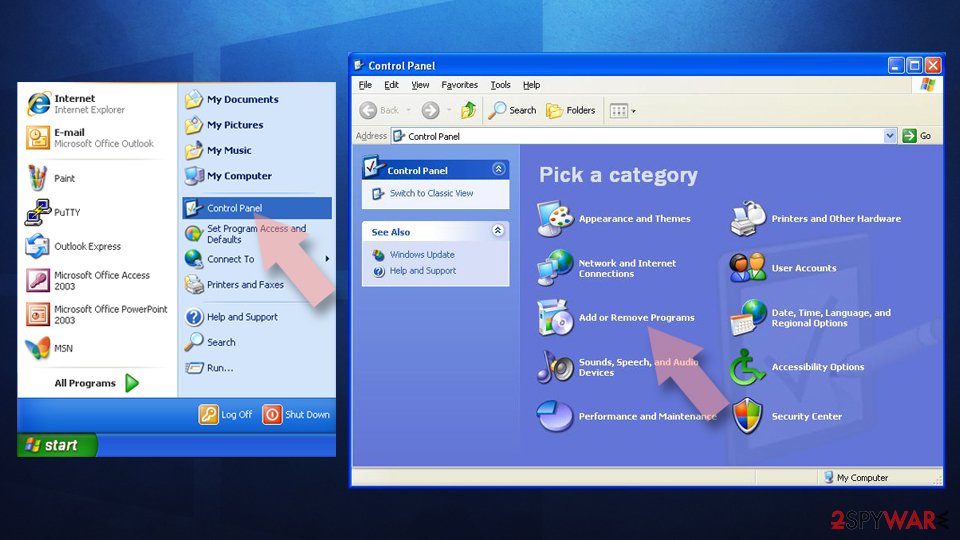
- Pick the unwanted application by clicking on it once.
- At the top, click Uninstall/Change.
- In the confirmation prompt, pick Yes.
- Click OK once the removal process is finished.
Delete from macOS
If you have spotted the adware-program on your Mac operating system, you can terminate the potentially unwanted application by completing this guide:
Remove items from Applications folder:
- From the menu bar, select Go > Applications.
- In the Applications folder, look for all related entries.
- Click on the app and drag it to Trash (or right-click and pick Move to Trash)
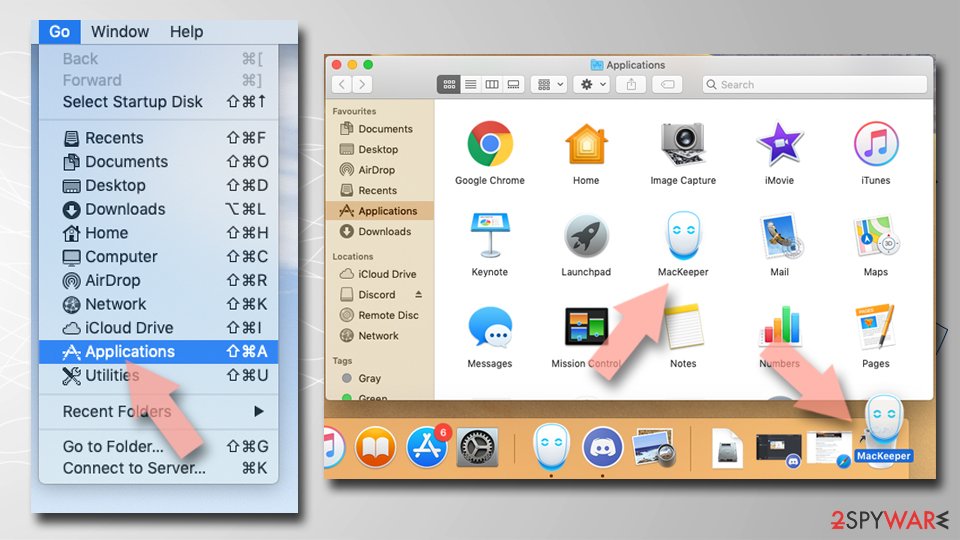
To fully remove an unwanted app, you need to access Application Support, LaunchAgents, and LaunchDaemons folders and delete relevant files:
- Select Go > Go to Folder.
- Enter /Library/Application Support and click Go or press Enter.
- In the Application Support folder, look for any dubious entries and then delete them.
- Now enter /Library/LaunchAgents and /Library/LaunchDaemons folders the same way and terminate all the related .plist files.
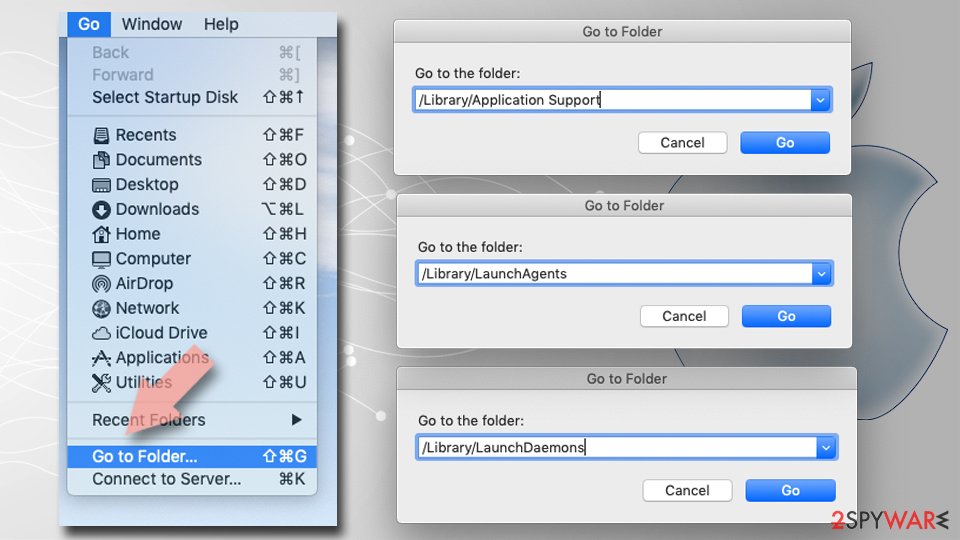
Remove from Microsoft Edge
Remove all suspicious-looking content from Microsoft Edge by following the instructions given below. Make sure you complete all steps exactly as shown in the guide in order to succeed in the process:
Delete unwanted extensions from MS Edge:
- Select Menu (three horizontal dots at the top-right of the browser window) and pick Extensions.
- From the list, pick the extension and click on the Gear icon.
- Click on Uninstall at the bottom.
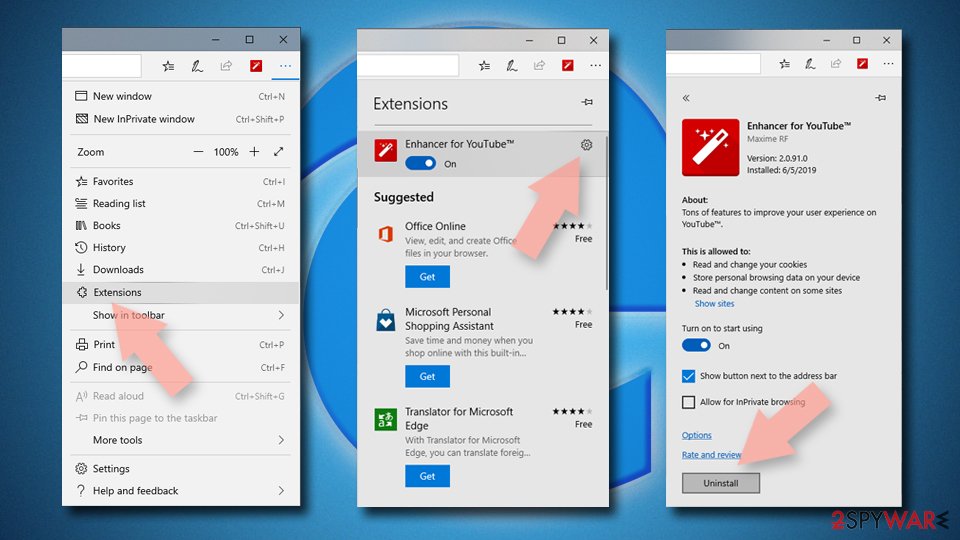
Clear cookies and other browser data:
- Click on the Menu (three horizontal dots at the top-right of the browser window) and select Privacy & security.
- Under Clear browsing data, pick Choose what to clear.
- Select everything (apart from passwords, although you might want to include Media licenses as well, if applicable) and click on Clear.
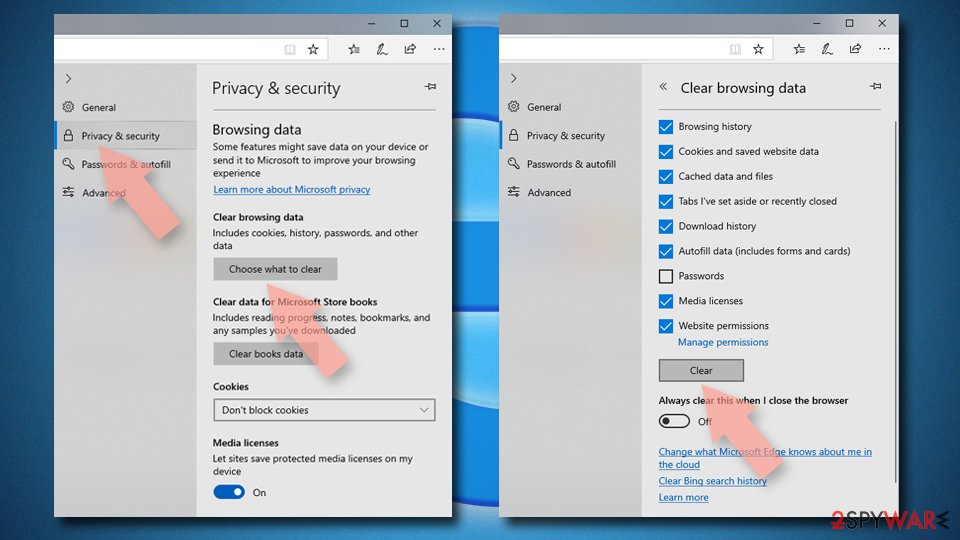
Restore new tab and homepage settings:
- Click the menu icon and choose Settings.
- Then find On startup section.
- Click Disable if you found any suspicious domain.
Reset MS Edge if the above steps did not work:
- Press on Ctrl + Shift + Esc to open Task Manager.
- Click on More details arrow at the bottom of the window.
- Select Details tab.
- Now scroll down and locate every entry with Microsoft Edge name in it. Right-click on each of them and select End Task to stop MS Edge from running.
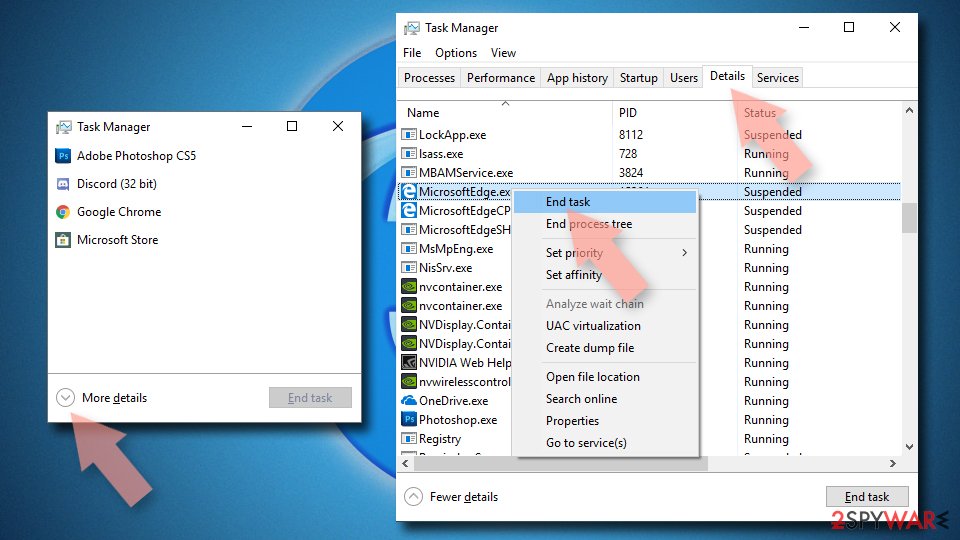
If this solution failed to help you, you need to use an advanced Edge reset method. Note that you need to backup your data before proceeding.
- Find the following folder on your computer: C:\\Users\\%username%\\AppData\\Local\\Packages\\Microsoft.MicrosoftEdge_8wekyb3d8bbwe.
- Press Ctrl + A on your keyboard to select all folders.
- Right-click on them and pick Delete
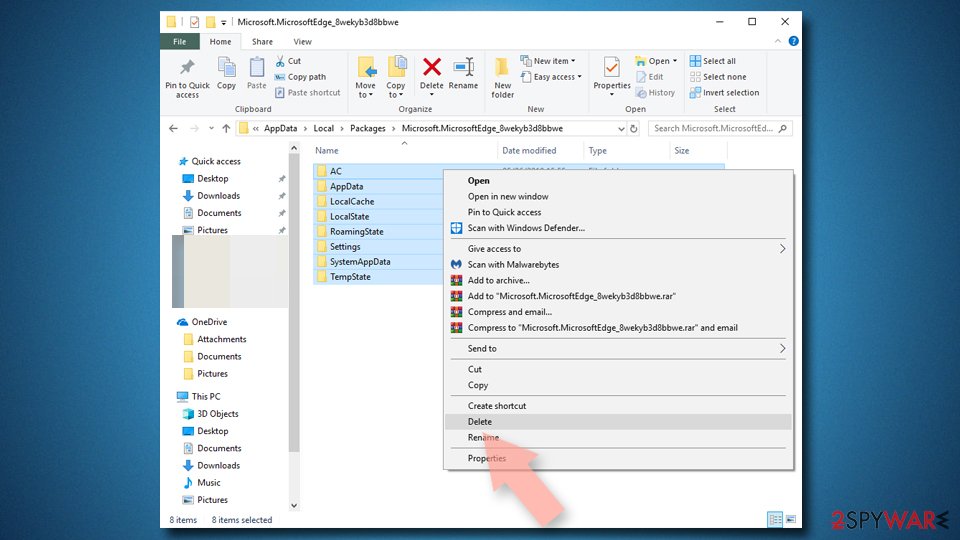
- Now right-click on the Start button and pick Windows PowerShell (Admin).
- When the new window opens, copy and paste the following command, and then press Enter:
Get-AppXPackage -AllUsers -Name Microsoft.MicrosoftEdge | Foreach {Add-AppxPackage -DisableDevelopmentMode -Register “$($_.InstallLocation)\\AppXManifest.xml” -Verbose
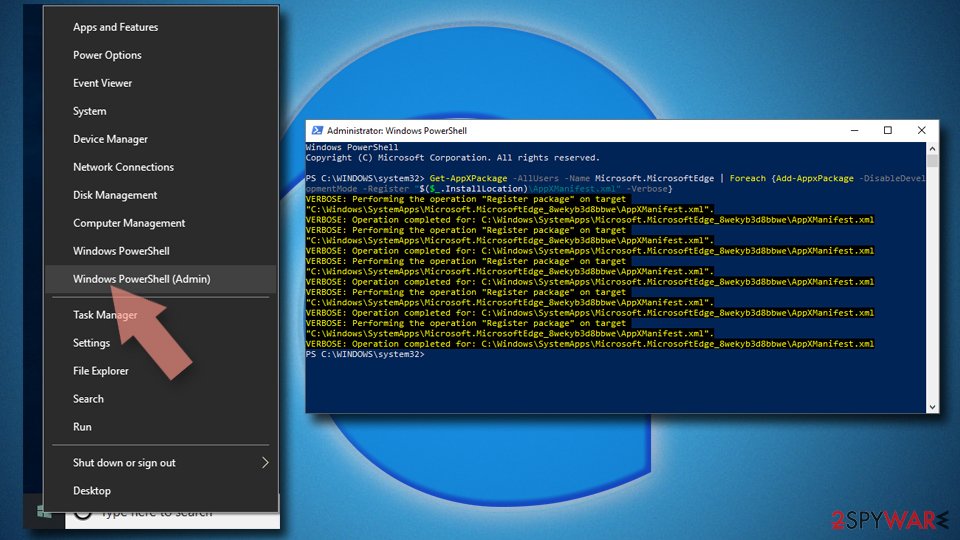
Instructions for Chromium-based Edge
Delete extensions from MS Edge (Chromium):
- Open Edge and click select Settings > Extensions.
- Delete unwanted extensions by clicking Remove.
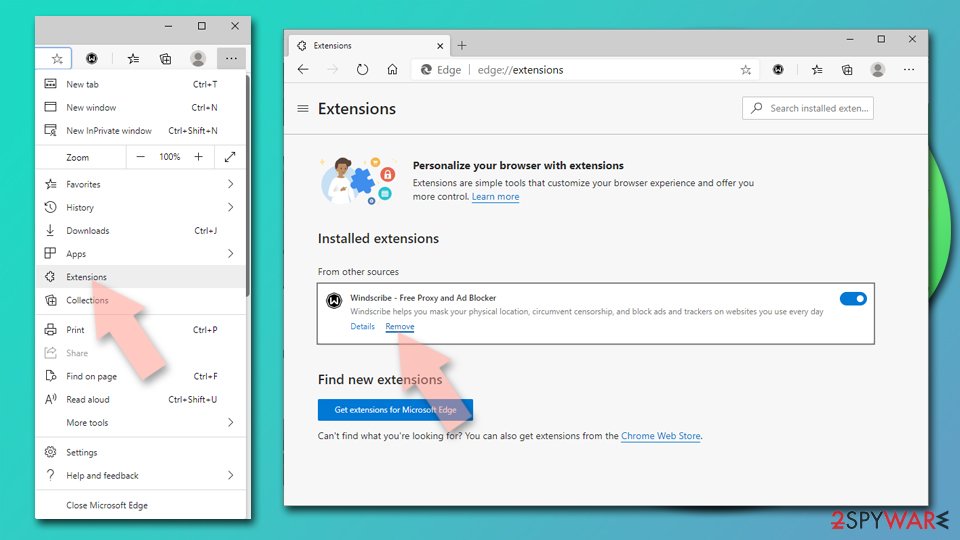
Clear cache and site data:
- Click on Menu and go to Settings.
- Select Privacy, search and services.
- Under Clear browsing data, pick Choose what to clear.
- Under Time range, pick All time.
- Select Clear now.
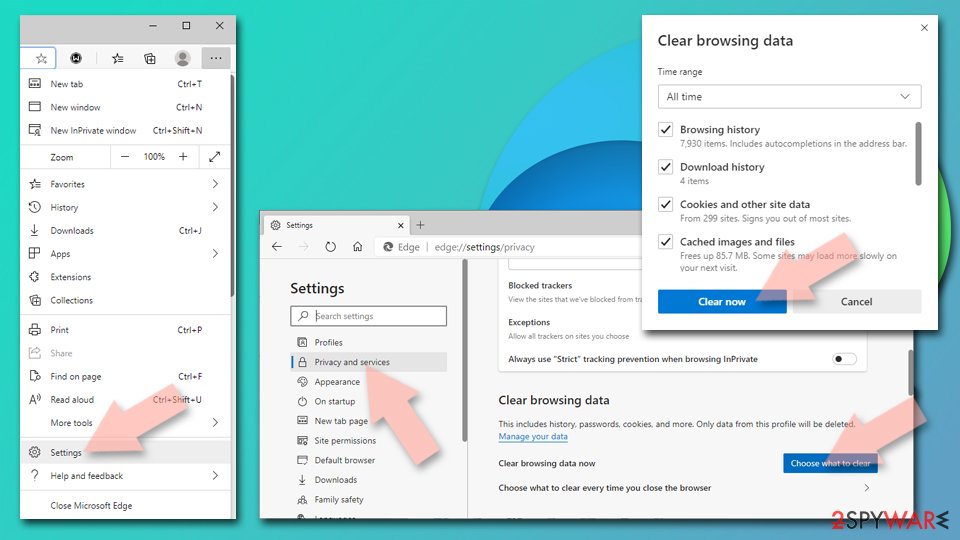
Reset Chromium-based MS Edge:
- Click on Menu and select Settings.
- On the left side, pick Reset settings.
- Select Restore settings to their default values.
- Confirm with Reset.
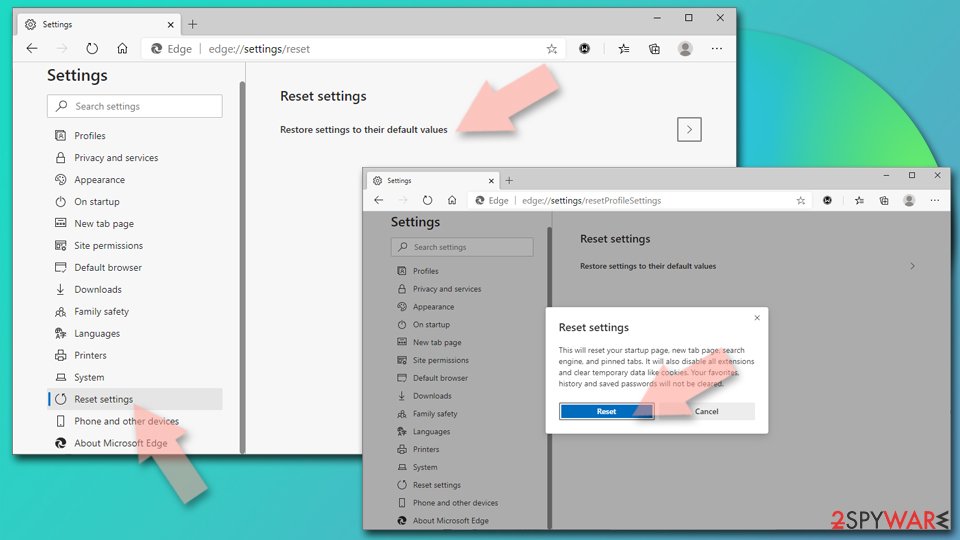
Remove from Mozilla Firefox (FF)
Terminate the adware program and all adware-added components from your Mozilla Firefox web browser by performing these guiding lines:
Remove dangerous extensions:
- Open Mozilla Firefox browser and click on the Menu (three horizontal lines at the top-right of the window).
- Select Add-ons.
- In here, select unwanted plugin and click Remove.
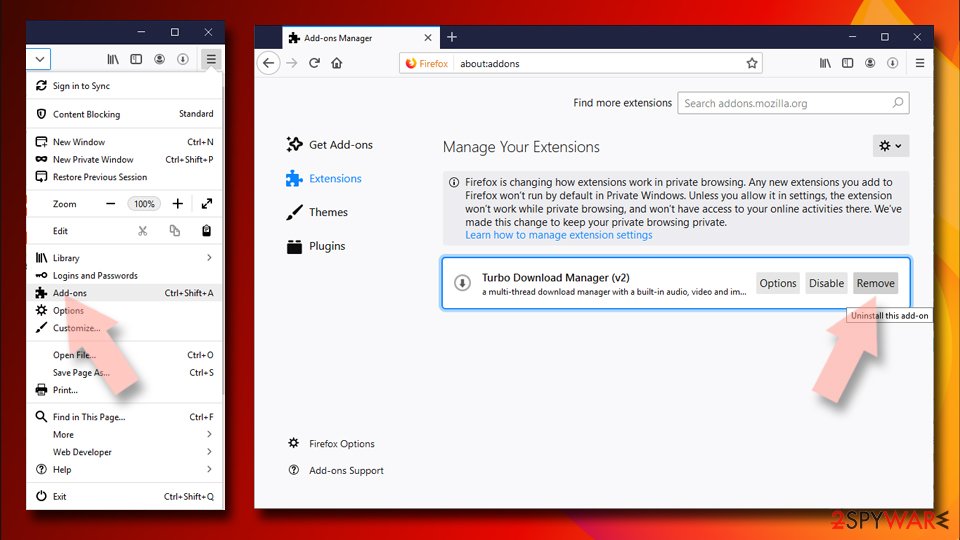
Reset the homepage:
- Click three horizontal lines at the top right corner to open the menu.
- Choose Options.
- Under Home options, enter your preferred site that will open every time you newly open the Mozilla Firefox.
Clear cookies and site data:
- Click Menu and pick Settings.
- Go to Privacy & Security section.
- Scroll down to locate Cookies and Site Data.
- Click on Clear Data…
- Select Cookies and Site Data, as well as Cached Web Content and press Clear.
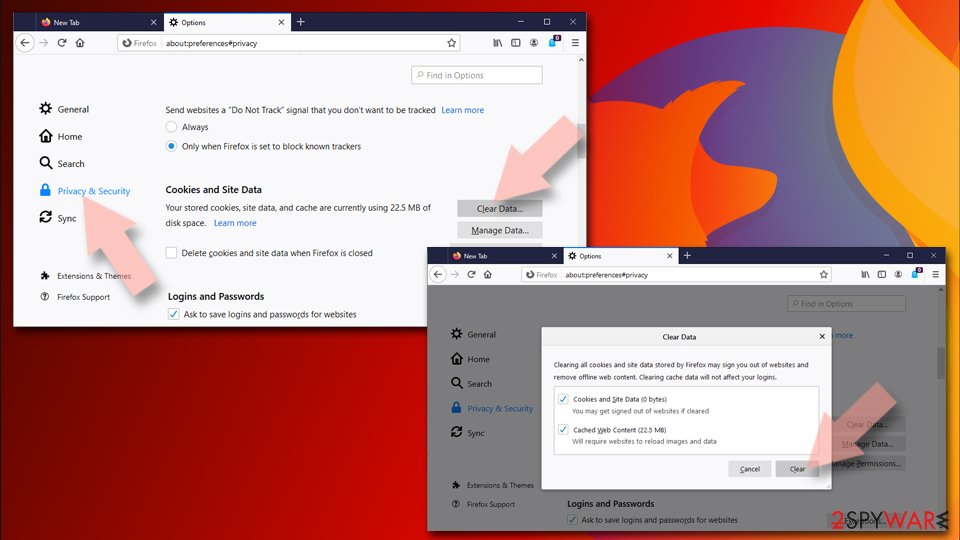
Reset Mozilla Firefox
If clearing the browser as explained above did not help, reset Mozilla Firefox:
- Open Mozilla Firefox browser and click the Menu.
- Go to Help and then choose Troubleshooting Information.
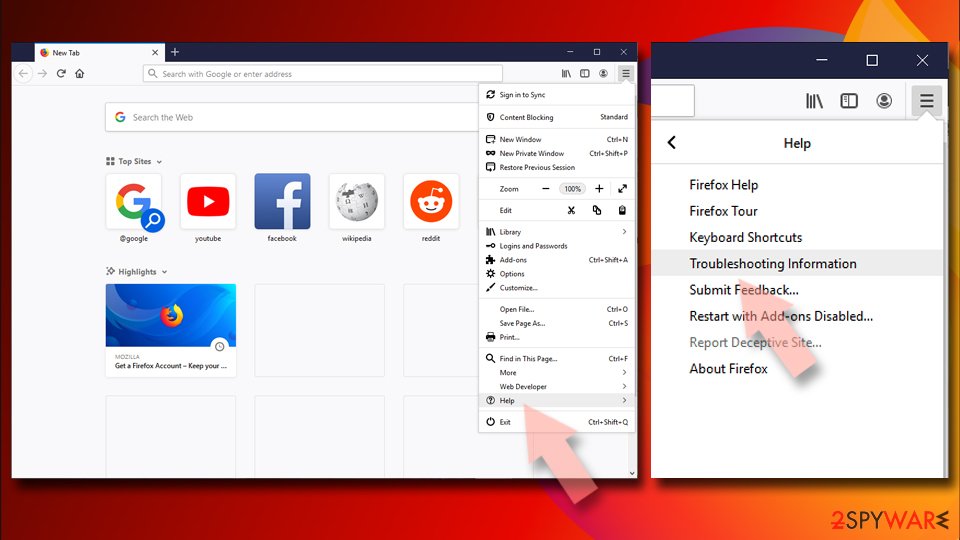
- Under Give Firefox a tune up section, click on Refresh Firefox…
- Once the pop-up shows up, confirm the action by pressing on Refresh Firefox.
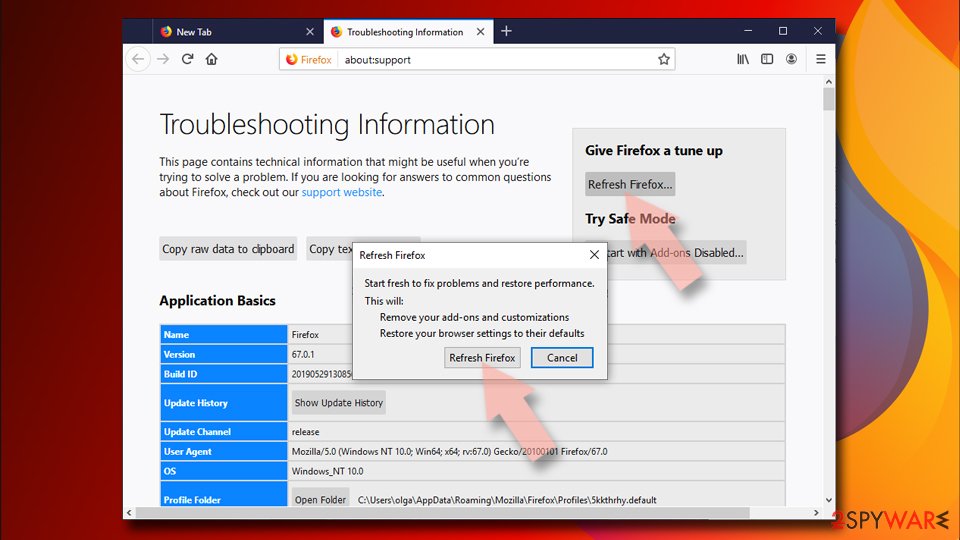
Remove from Google Chrome
Spotting Ads by TS on your Google Chrome web browser is not a great sign. You should remove the PUP as soon as you spot the first adware signs. Use these instructions if help is needed:
Delete malicious extensions from Google Chrome:
- Open Google Chrome, click on the Menu (three vertical dots at the top-right corner) and select More tools > Extensions.
- In the newly opened window, you will see all the installed extensions. Uninstall all the suspicious plugins that might be related to the unwanted program by clicking Remove.
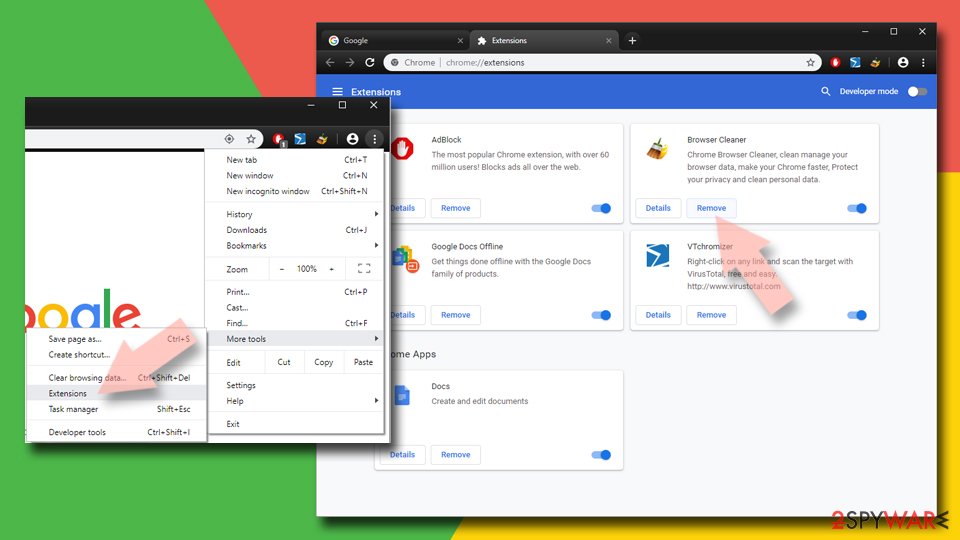
Clear cache and web data from Chrome:
- Click on Menu and pick Settings.
- Under Privacy and security, select Clear browsing data.
- Select Browsing history, Cookies and other site data, as well as Cached images and files.
- Click Clear data.
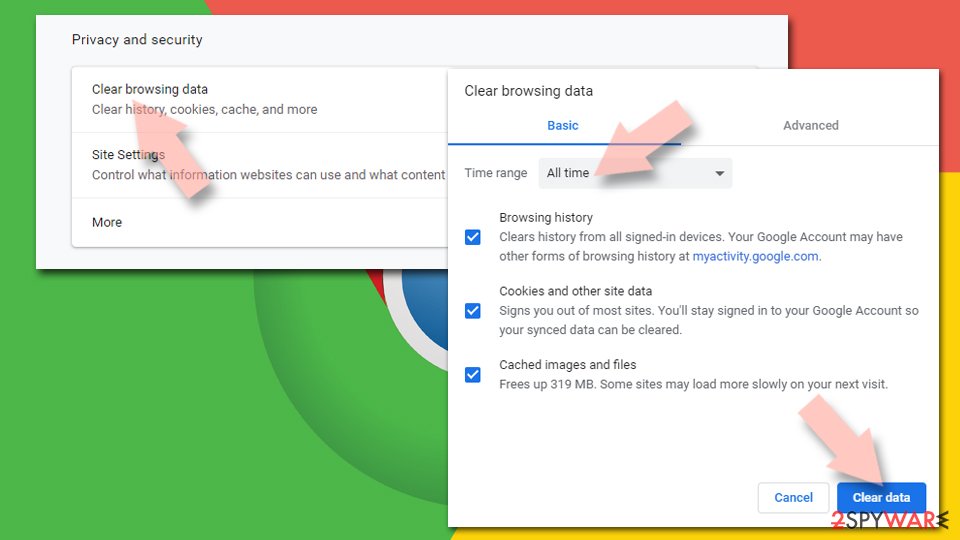
Change your homepage:
- Click menu and choose Settings.
- Look for a suspicious site in the On startup section.
- Click on Open a specific or set of pages and click on three dots to find the Remove option.
Reset Google Chrome:
If the previous methods did not help you, reset Google Chrome to eliminate all the unwanted components:
- Click on Menu and select Settings.
- In the Settings, scroll down and click Advanced.
- Scroll down and locate Reset and clean up section.
- Now click Restore settings to their original defaults.
- Confirm with Reset settings.
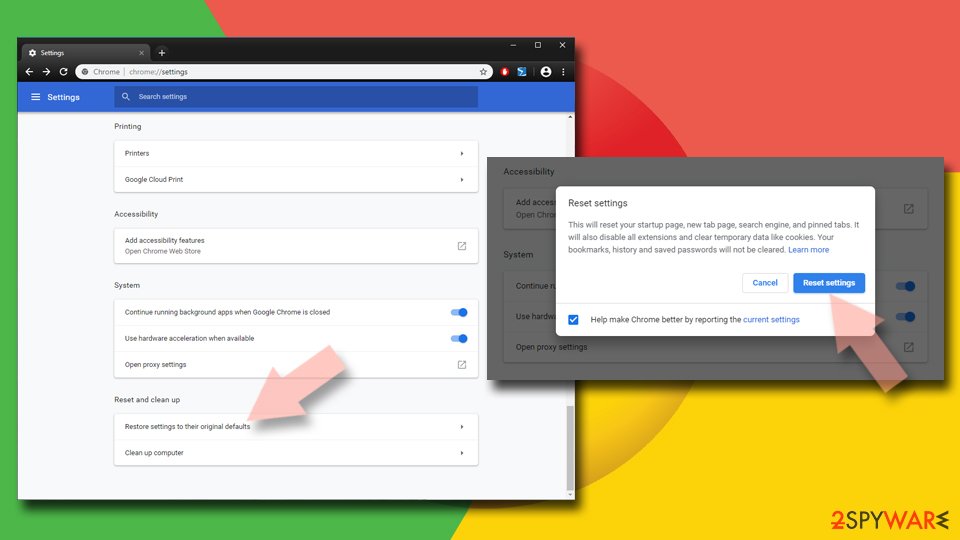
Delete from Safari
If you have overcome adware in your Safari browser, note that, you can safely and successfully remove the PUP by using this guide:
Remove unwanted extensions from Safari:
- Click Safari > Preferences…
- In the new window, pick Extensions.
- Select the unwanted extension and select Uninstall.
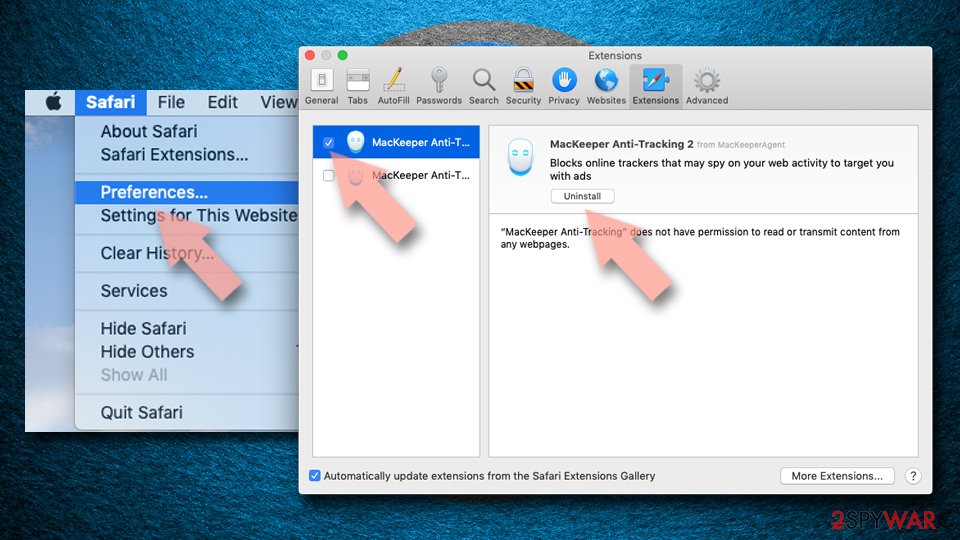
Clear cookies and other website data from Safari:
- Click Safari > Clear History…
- From the drop-down menu under Clear, pick all history.
- Confirm with Clear History.
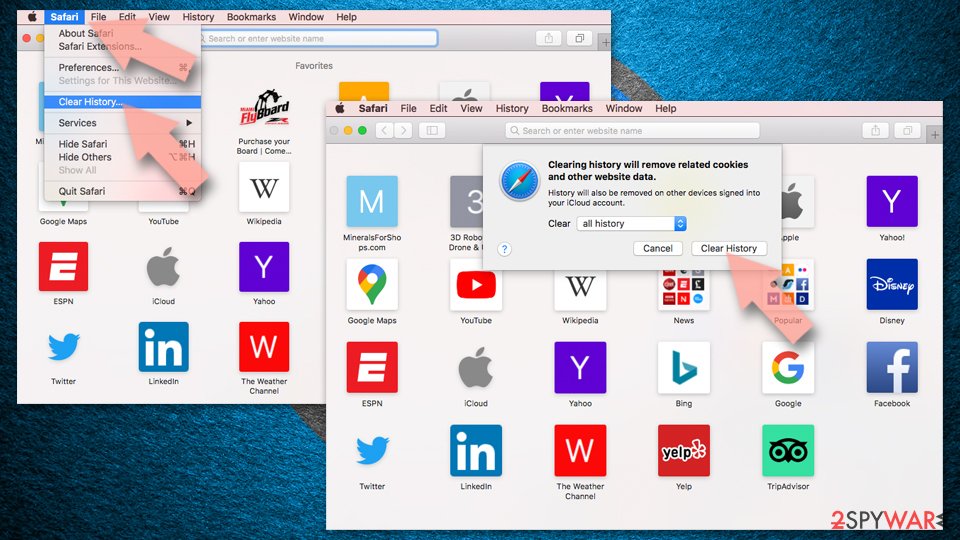
Reset Safari if the above-mentioned steps did not help you:
- Click Safari > Preferences…
- Go to Advanced tab.
- Tick the Show Develop menu in menu bar.
- From the menu bar, click Develop, and then select Empty Caches.
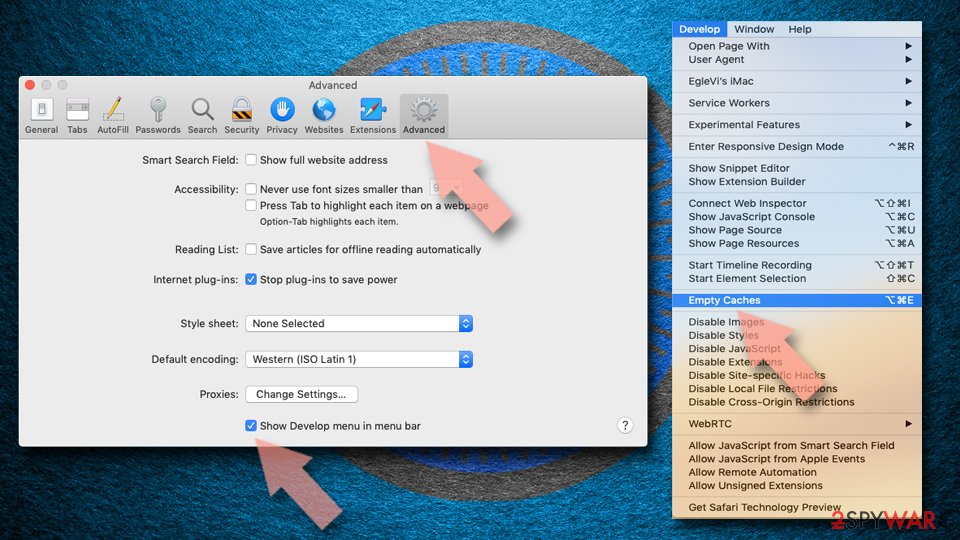
After uninstalling this potentially unwanted program (PUP) and fixing each of your web browsers, we recommend you to scan your PC system with a reputable anti-spyware. This will help you to get rid of TS registry traces and will also identify related parasites or possible malware infections on your computer. For that you can use our top-rated malware remover: FortectIntego, SpyHunter 5Combo Cleaner or Malwarebytes.
How to prevent from getting adware
Access your website securely from any location
When you work on the domain, site, blog, or different project that requires constant management, content creation, or coding, you may need to connect to the server and content management service more often. The best solution for creating a tighter network could be a dedicated/fixed IP address.
If you make your IP address static and set to your device, you can connect to the CMS from any location and do not create any additional issues for the server or network manager that needs to monitor connections and activities. VPN software providers like Private Internet Access can help you with such settings and offer the option to control the online reputation and manage projects easily from any part of the world.
Recover files after data-affecting malware attacks
While much of the data can be accidentally deleted due to various reasons, malware is one of the main culprits that can cause loss of pictures, documents, videos, and other important files. More serious malware infections lead to significant data loss when your documents, system files, and images get encrypted. In particular, ransomware is is a type of malware that focuses on such functions, so your files become useless without an ability to access them.
Even though there is little to no possibility to recover after file-locking threats, some applications have features for data recovery in the system. In some cases, Data Recovery Pro can also help to recover at least some portion of your data after data-locking virus infection or general cyber infection.
- ^ Margaret Rouse. Adware. Search Security. Tech Target.
- ^ Jpch. "Ads by TS" injected in Google search results. Malwarebytes. Tech forum.
- ^ Jake Frankenfield. Cost Per Click - CPC. Investopedia. Relevant terms.
- ^ Virusai.lt. Virusai. Virus-related news and technology information.
